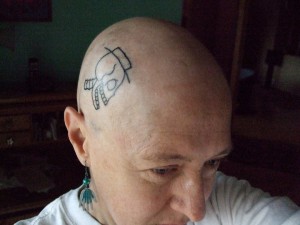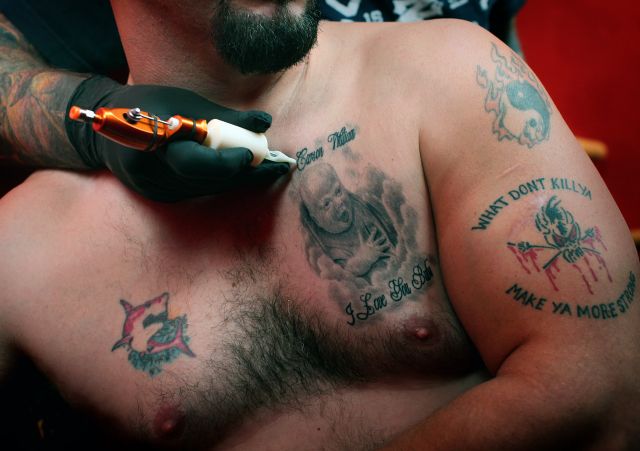In honor of the one year anniversary of Juanita’s death, I’m again sharing the memorial post I wrote for her. If you missed it last time, please take a look.
Tag: memorial tattoos
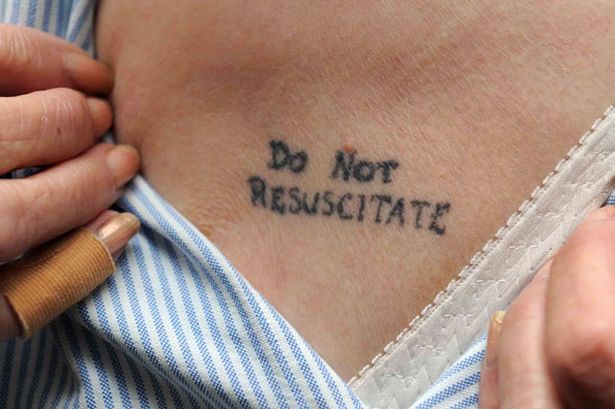
Tattoos Replacing Medical-Alert Bracelets for Those with Diabetes, Other Ailments
Aisling Swift, Scripps Howard News Service
Ladies and Gentlemen. Dearest Death Reference Desk Readers. Lovers of all things Death, Dying, and Dead Body.
We are witnessing an entirely new tattoo genre not only take flight but unquestionably cement itself into daily life. The Medical Alert Tattoo will not, cannot, oh my goodness no no no, go away!
In mid-June I wrote about recent developments in Medical Alert Tattooing: Do Not Resuscitate this Tattoo. Or the Person Attached to It.
This most recent article by Scripps Howard seems to have suspiciously borrowed some ideas from ye olde Death Reference Desk but it’s cool.
In a nutshell, people from all different kinds of backgrounds and age groups are having various medical condition alerts tattooed onto their bodies. So, for example, Type I or II Diabetes on the wrist. But many people are also having DO NOT RESUSCITATE tattooed onto their chest. We’ve been covering these DNR tattoos since Death Ref’s humble beginnings in 2009.
And now, it seems, the Do Not Resuscitate tattoos are a real phenomena.
As with any discussion on DNR (or other Medical Alert) tattoos, it’s important to state that medical staff are not necessarily going to follow the tattooed request. At least not the Do Not Resuscitate part.
But if you go for the ink, then no one can doubt your commitment. And that’s a political statement unto itself.
Special Note: Send the Death Reference Desk photos of your DNR or Medical Alert Tattoos. We want to start a photo collection.
Medical Alert Tattoo Replaces Bracelet on Type 1 Diabetic
Susan Kreimer, AARP Bulletin (June 6, 2012)
Medical Alert Tattoos. This is my new favorite tattooing term. It is the perfect blend of utility, pragmatism and bad ass ink.
We’ve been covering Memorial Tattoos for a while on Death Ref and you can see those posts here.
All credit goes to the AARP (formerly the American Association of Retired Persons) for publishing this short article on its members who choose different kinds of Medical Alert Tattoos. I already knew about the Do Not Resuscitate tattoos. In December 2008, an older Death with Dignity activist in New Zealand gained international attention when she got her own DNR tattoo. And in late 2011, an 81-year old British woman did the same thing.

The AARP discusses other MAT’s (a new tattooing acronym!), such as putting ‘Type-1 Diabetic’ on a person’s wrist.
I fully support the use of Medical Alert Tattoos. 100%. Indeed, these tattoos represent a form of older person activism that I really respect.
MAT’s also give the grandkids something to tell their friends about.
But any Medical Alert Tattoo, especially a Do Not Resuscitate tattoo, comes with a cautionary note: the status quo is still a piece of jewelry or a written order. The tattoos won’t necessarily register as a person’s officially and legally recognized choice. Paradoxically as that sounds.
The AARP also flags up this issue:
A word of caution: First responders aren’t trained to look for tattoos, and skin damage in accidents can obscure them, says Rebecca Dinan Schneider, spokeswoman for the National Association of Emergency Medical Technicians. “Medical alert jewelry is still the standard.”
One day this will change. And perhaps sooner than we might imagine.
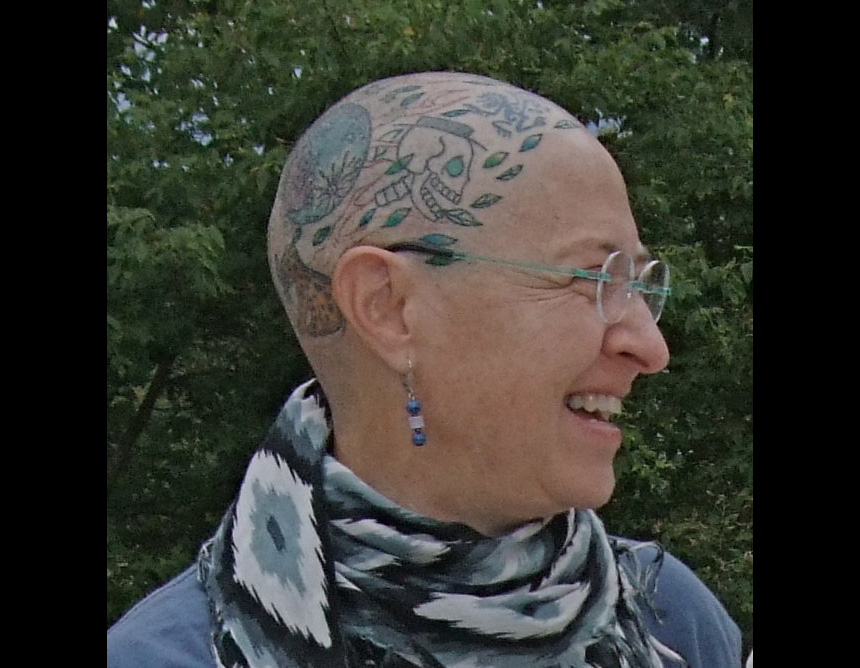
My good friend Juanita Garciagodoy died on Thursday, October 27, 2011. She was 59.
In July 2009, Juanita told me via e-mail that she had breast cancer and that it had metastasized. This was at the same time that the Death Reference Desk launched. I had sent Juanita a rather silly message about why she should check out the Death Reference Desk since she was a Meso-American studies scholar who had written about the Day of Dead (Día de los Muertos). She responded with her usual strong support and the fact that she was dying.
Suffice it to say that I felt like an idiot. A big one.
I promised Juanita that after she died, I would write about her for the Death Reference Desk. She reminded me of this promise over the years, most recently in our very last e-mail communication at the end of September 2011:
John,
Thank you for your sweet note.
Remember? You owe me an obituary, my friend. No pressure, of course.
Love,
Juanita
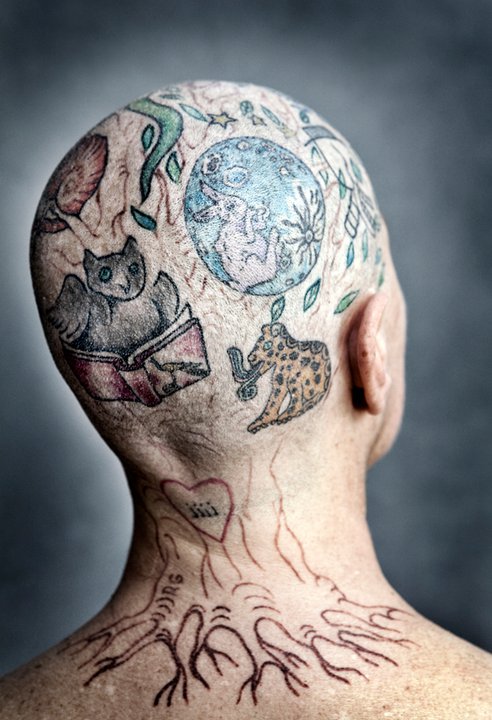 Que Si, Juanita Garciagodoy. I do remember. And with tears streaming from my eyes while I type these words, I am honored to remember our friendship in writing.
Que Si, Juanita Garciagodoy. I do remember. And with tears streaming from my eyes while I type these words, I am honored to remember our friendship in writing.
I first met Juanita in October 2001 at an academic conference in Puebla, Mexico. It was the first time that I presented my Ph.D. research on the dead body and Juanita was unbelievably enthusiastic about my studies. Without any question, Juanita was the first academic from outside my own institution who expressed deep interest and support for my work. That we met in Mexico was a little ironic since she was a Professor at Macalester College in St. Paul, Minnesota and I was at the University of Minnesota in Minneapolis, Minnesota.
Juanita and I stayed in touch over the years, mostly by e-mail. From time to time she would send me news articles about a dead body topic. And by send, I mean she would physically cut them out and put the articles in the mail. I was particularly fond of the article on beetles that strip away cadaveric flesh. In 2005 she attended my Ph.D. defense (which is true sign of selfless friendship, let me just say) and in 2006 she brought an entire crowd of people to watch my one-man show On The Untimely Death of John Erik Troyer, Ph.D. at the Bryant-Lake Bowl Theatre. In a nutshell, Juanita showed herself to be a wonderful friend during important moments in my adult life.
In June 2010, I gave a keynote lecture on Memorial Tattoos for the Death, Commemoration, and Memory conference in Edinburgh, Scotland. Over the last few years, I’ve begun researching the history of tattooing and its relationship to human mortality. A central figure in that talk was Juanita. Indeed, Juanita has become (and will remain) a key figure in any talk that I give on tattooing.
After Juanita lost her hair due to radiation treatments, she decided to cover her head with tattoos. It is important to note, I think, that prior to this moment Juanita had never gotten a tattoo of any kind before. So not only did she choose to get a tattoo, she chose to tattoo her head – the most visible (and next to the face) hardest part of the tattooed human body to hide. Over a course of months, Juanita went from zero tattoos to a head full of colorful ink. She had her tattoos done at Leviticus Tattoos in Minneapolis, which I know she would want people to know.
It is Juanita’s tattoos that I want to discuss and remember the most. To the end of her days she defied conventional wisdom about how a person should live her life while dying from breast cancer. Her tattoos were, for me, a brilliant and moving outward expression of that defiance.
Juanita also had some seriously bad ass ink and the stories that her tattoos tell/told bear retelling here.
When Juanita first lost her hair she experimented with painting her head, but the paint rubbed off so she decided that tattoos were the logical solution. She and I spoke at length about the deeper reasons for the tattoos; the reasons that turned her tattoos into a profound choice about confronting death.
 She saw the tattoos as part of her identity and she felt that the visual collage on her head helped her assert the inevitability of her own death. On more than one occasion, Juanita told me that her tattoos were both a confrontation with life and a liberatory act in the face of death.
She saw the tattoos as part of her identity and she felt that the visual collage on her head helped her assert the inevitability of her own death. On more than one occasion, Juanita told me that her tattoos were both a confrontation with life and a liberatory act in the face of death.
A great irony attached itself to her tattoos: Juanita wanted the tattoos so that people would talk about something, anything, other than her cancer. I always admired this particular reason – instead of waiting for the other person to think of a conversation topic, just give that person a bunch of tattoos staring them in the face as a tour de force kind of ice breaker. Sadly, and on many occasions, people would go to great lengths to avoid discussing the tattoos. She and I laughed about this situation, since her tattooed head was an obvious discussion topic. Alas, many people were either afraid to ask or couldn’t be bothered and it was their loss.
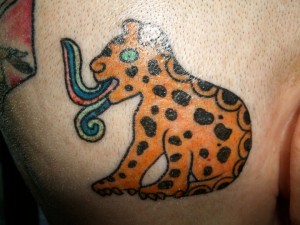
Here, then, are the stories that Juanita’s tattoos tell (as told to me by Juanita) and in no particular order:
The Singing Jaguar: a Meso-American poet symbol. Juanita wanted a representation of an ancient poet symbol to reflect her own writing.
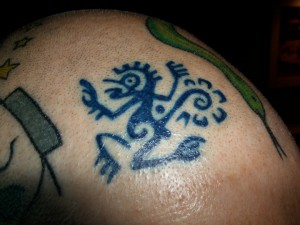 Ozomahtli the Monkey: Mexican seal used to imprint objects. Juanita always felt that it was a beautiful design. Ozomahtli is also associated with spring, with song, with poetry, and with fertility in other contexts.
Ozomahtli the Monkey: Mexican seal used to imprint objects. Juanita always felt that it was a beautiful design. Ozomahtli is also associated with spring, with song, with poetry, and with fertility in other contexts.
Grasshopper on Mountain: Pre-Spanish design from an Aztec art book. This was also the symbol for Juanita’s favorite park in Mexico City.
Rabbit in the Moon: In Meso-American story telling, Rabbit is said to have previously been a god, a humble god, who agreed to illuminate the night. As a result, Meso-American storytellers described seeing a rabbit in the moon. The rabbit was designed by friend from a prehistoric pot image. The moon image is taken from NASA, complete with craters. Juanita told me that she felt close to the moon. For her the moon was poetic and mysterious.
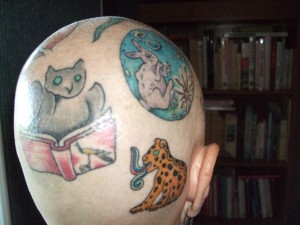 Owl hovering over a Book: The owl represented wisdom and it showed Juanita’s commitment to knowledge by reading the book. The peacock on the book’s cover is taken from the cover of a novel by her husband George. Juanita also explained to me that there is an old Mexican saying: When the owl sings the Indian dies. She believed that this saying described a confrontation with mortality that she, herself, was going through.
Owl hovering over a Book: The owl represented wisdom and it showed Juanita’s commitment to knowledge by reading the book. The peacock on the book’s cover is taken from the cover of a novel by her husband George. Juanita also explained to me that there is an old Mexican saying: When the owl sings the Indian dies. She believed that this saying described a confrontation with mortality that she, herself, was going through.
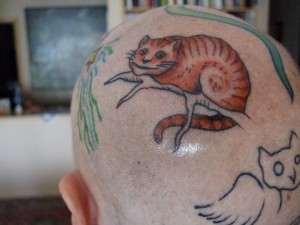 Cheshire Cat: Juanita wanted a cat tattoo and she loved Alice in Wonderland. This was also a tattoo to remember all the dead pets.
Cheshire Cat: Juanita wanted a cat tattoo and she loved Alice in Wonderland. This was also a tattoo to remember all the dead pets.
Heart with jjjj: This was a code for “Juanita’s Handsome Husband Jorge.” I can’t replicate the accent that Juanita used to say those words, but it was very funny. The heart was also for love since Juanita and George loved each other very deeply.
Tree: The tree of knowledge which surrounded her head.
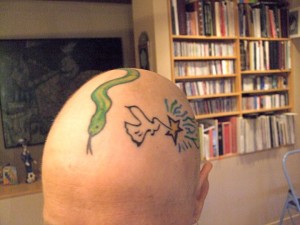 Snake: A symbol of knowledge and transgression, as when Eve eats the apple in the Garden of Eden.
Snake: A symbol of knowledge and transgression, as when Eve eats the apple in the Garden of Eden.
Humming Bird sipping out of a Star: Juanita loved the beauty of this image. The Hummingbird is also featured in ancient Meso-American stories. Three groups of people turned into hummingbirds or butterflies when they died: warriors who died in battle, people who were sacrificed, and women who died in childbirth. Juanita told me that at times she felt like her own body was sacrificing itself and betraying her. She often felt that she was battling cancer as a warrior.
El Don Quixote: Last but not least. Don Quixote was her first tattoo. Initially, Juanita was only going to get Don Quixote because she was told that the process might hurt. As is totally obvious, Juanita had the exact opposite reaction to the pain from that first tattoo. The image is by the artist Posada. Juanita told me that Posada was the kind of artist who pulled death into life with a great sense of humor. El Don Quixote also reminded her of the Day of the Dead, which was an area of her own research. Her 2000 book, Digging the Days of the Dead: A Reading of Mexico’s Dias de Muertos, had three Don Quixote’s on its cover.
One other important detail: all of the creatures have green-blue eyes, like Juanita’s eyes.
Even after it was possible for Juanita to grow her hair back, she decided to keep her head shaved. It was important to her that the tattoos be visible. Juanita explained to me that her tattoos were producing stories about her and her life.
Those tattooed stories, which live on today and will thrive for some time to come, are the narrative traces of Juanita Garciagodoy’s life.
These stories are also Juanita’s permanently inked memorial.
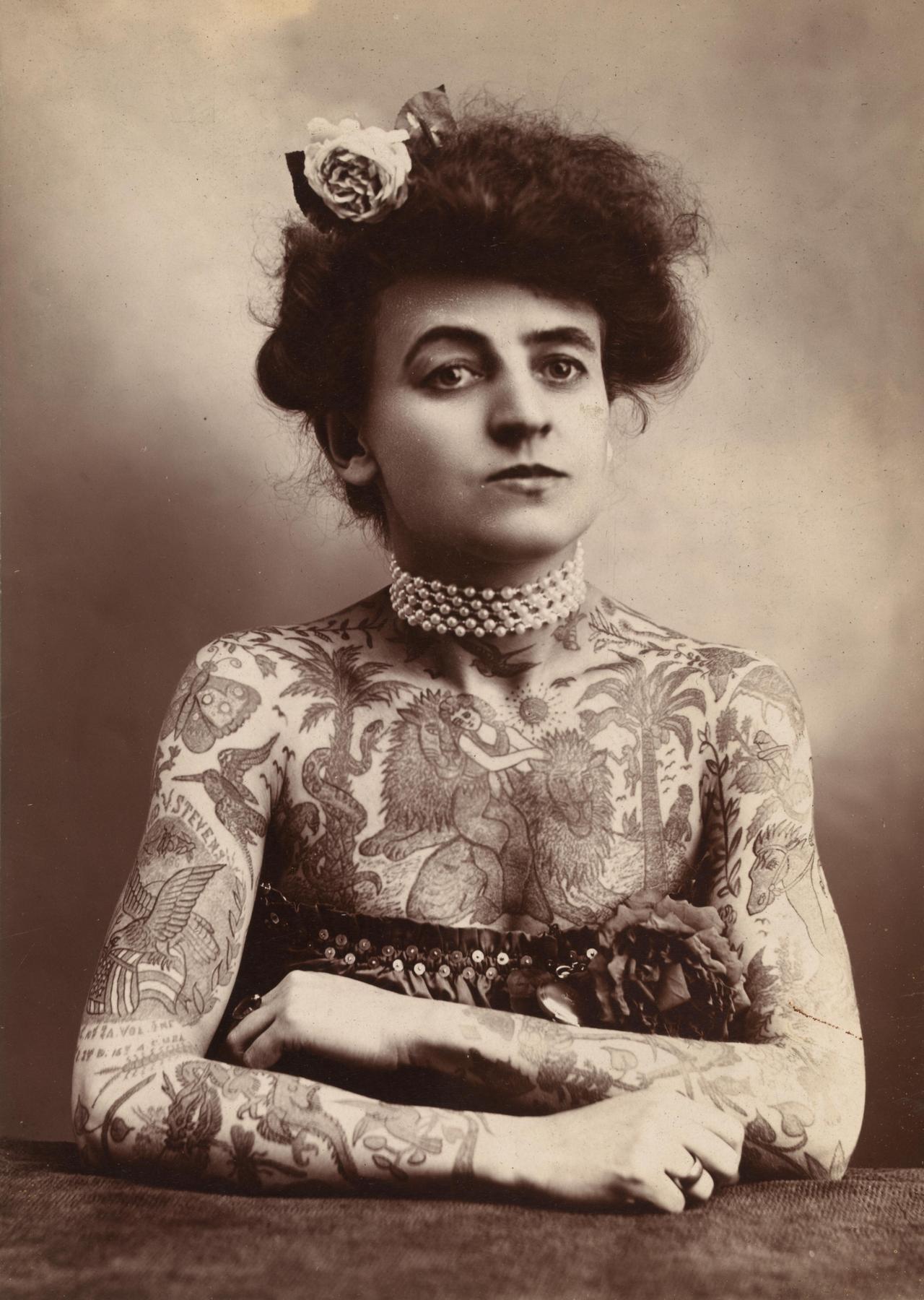
History of Hip: Art With A Point, ‘A Brief History of Tattoos’
Minnesota History Center
345 Kellogg Boulevard W
Saint Paul, MN 55102-1906
Dates: January 11, 2011
Time: 7:30 to 9 p.m.
Fee: FREEEEE (but $5.00 to park in the MNHS parking lot)
Reservations: recommended, call 651-259-3015
Please note: This event has been moved from the Turf Club, which has been closed temporarily. Wine and beer are available for purchase in the History Center’s Cafe Minnesota.
A few years ago, Minneapolis tattoo artist Awen Briem and I gave a joint talk on Memorial Tattoos. In fact, you can read all about Memorial Tattoos here on the Death Reference Desk. Meg, Kim, and I have been fielding questions about the ins and outs of these tattoos since day one of Death Ref.
On January 11, 2011, Awen and I will be together again to discuss tattooing. This particular talk will be in St. Paul, MN at the world famous Minnesota Historical Society. We will be discussing the broader history of human tattooing, with special attention paid to memorial tattoos.
The talk is sponsored by the Minnesota Historical Society and a big high-five to the MNHS for organizing a series called the History of Hip.
A complete description of the tattoo talk is below. And you can read all about Awen at her tattoo studio’s website Art With A Point.
History of Hip: Art With A Point, ‘A Brief History of Tattoos’
Minnesota History Center, St Paul MNDates: January 11, 2011
Time: 7:30 to 9 p.m.
Fee: FREEEEE
Reservations: recommended, call 651-259-3015 or register online
Never just the domain of sailors and outlaws, tattoos have a rich and storied history. From Pacific Islanders to American hipsters, body art has long been a popular form of self expression with many layers of meaning. Dr. John Troyer will discuss the history of human tattooing, as well as some of the key traditions associated with the practice. Tattoo artist Awen Briem will weigh in on tattoo customs and share thoughts on memorable designs and clients she’s worked with at her studio, Art With A Point.
History of Hip explores the mysterious factors that confer hipness on an artist or a fad, and trace the origins of creative genres that still register with artists, audiences, and tastemakers today. Snacks provided.
Valerie’s New York interview with John Troyer on Memorial Tattoos
WOR 710 AM (August 4, 2010)
Here is the link for the radio interview I did on with Valerie Smaldone on Valerie’s New York . I start discussing Memorial Tattoos about 17:30 minutes into the interview.
The piece before me is on an event promoter offering free tickets to shows when people get his logo tattooed onto their body. Good times.
Valerie asked good questions.
I look forward to a return visit to Valerie’s New York.
Morbid Ink: Memorial Tattoos
Samantha Stark, WNYC radio (July 21, 2010)
WNYC radio in New York put together a short piece on Memorial Tattoos, which coincided with my talk on the same subject for Observatory and the Morbid Anatomy Library.
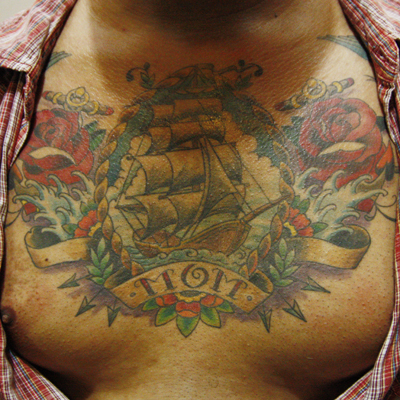 Samantha Stark, the WNYC reporter who put the story together, did a really good job of tracking down individuals and tattoo artists with memorial tattoos. I found those interviews far more compelling than anything I said.
Samantha Stark, the WNYC reporter who put the story together, did a really good job of tracking down individuals and tattoo artists with memorial tattoos. I found those interviews far more compelling than anything I said.
But I’m not surprised.
Memorial Tattoos almost always contain a narrative which overpowers any historical/conceptual argument.
These tattoos are a story about how one person died and another individual continues to live with his or her memory.
And that will never change.
Morbid Ink: Field Notes on the Human Memorial Tattoo
An Illustrated Lecture with Dr. John Troyer, Deputy Director, Centre for Death and Society, University of Bath
Date: Tuesday July 20th, 2010
Time: 8:00pm
Admission: $5
On Tuesday, July 20 I am giving a talk in Brooklyn on memorial tattoos. The talk, Morbid Ink: Field Notes on the Human Memorial Tattoo, focuses on research that I have been doing for a number of years. Many thanks to Joanna Ebenstein who runs the Morbid Anatomy Library for inviting me to speak.
The academic side of this research has really only taken place during the last year. But the tattoo side of my work started in 1994 when I got my first memorial tattoo for my maternal grandfather. Since 1994, I have gotten a tattoo for each of my grandparents, in the order of their deaths, down my spine. I went to the same tattoo artist for each of the tattoos, Awen Briem, and you can see her work at her studio Art With a Point. In 2008, I got tattoos for both my parents (who are still alive) as a way of honoring them before they die. Each of these tattoos is a 1/4 long sleeve down both my left and right arms. Awen did an amazing job with these tattoos too.
All of this is to say that I have spent hours and hours (and more hours…) thinking and talking with Awen about why people get tattoos. It became apparent, based purely on Awen’s anecdotes, that memorial tattoos were becoming more and more common. In case you are looking for a definition, the Memorial Tattoo is most easily described as a tattoo which a person gets after someone they know dies. The deceased can be a good friend, a spouse, sibling, lover, etc. Now, the memorial tattoo can also be for a dead pet and I see this kind of tattoo more and more. Indeed, Awen ran some numbers and roughly 50% of her memorial tattoos are for pets. This all makes sense to me since pets became a companion species for humans long ago.
The talk on July 20th will discuss a variety of issues which I think memorial tattoos produce. Some of these issues include how meaning is assigned to a memorial tattoo, what marking a living body with representations of death entails, and current innovations in memorial tattooing.
I will also talk about the strange and peculiar avenues this particular research interest has taken me down. My favorite example is that the Death Reference Desk has itself become part of my research.
Last July, I posted an article on Death Ref about a gentleman who got cremated human remains mixed into the ink used for a memorial tattoo. As a result of that post, the Death Reference Desk has started receiving questions about the ins and outs of mixing cremated remains into tattoo ink.
And since Death Ref has always functioned as a reference desk, Meg, Kim and myself have responded to all the queries. Meg, in particular, has gone to great lengths to answer these questions and those responses are still available here: Using Cremains in Memorial Tattoos. You can also find more on memorial tattoos here.
It turns out that quite a few people have thought about/are thinking about mixing a pinch of human ash (almost always from the deceased) into the ink being used for a specific memorial tattoo.
I’m not surprised in the least. Within the logic of why people get memorial tattoos, it makes complete sense.
If you are in the Brooklyn area Tuesday and/or know someone who is, then send them to the Morbid Anatomy Library at 543 Union Street, Brooklyn, New York 11215 for the talk.
Samantha asks the Death Reference Desk:
A couple relatives and I just had my aunt’s ashes put in ink for a memorial tat. My question is since she was so sick, will there be a transfer or will it be okay since she was cremated?
The short answer is: Yes, it’ll be okay. Cremators run between 1400 and 1800 degrees Fahrenheit, which is well beyond hot enough to destroy the pathogens that made the aunt sick. As a result, the cremains will be rendered nonhazardous and useable in tattoo ink.
The long answer is also: Yes, it’s okay, meaning there won’t be a risk of catching her disease. However… internet scavenging and talking with those in the know reveal a lot of confusion about the health risks with using cremains in memorial tattoos: hearsay, misinformation, nondisclosure and a heck of a lot of personal experience — much of it positive — but nothing by way of definitive research or official guidelines from either the tattooing community or health officials.
We get a lot of traffic at DeathRef from people searching for info on memorial tattoos and the use of cremains therein; sparked by Samantha’s question, I decided to do some more digging. A quick note for those unfamiliar with the topic: a memorial tattoo is any tattoo that commemorates a deceased loved one (person or pet), perhaps with his or her image, name, birth and death dates or other personal or religious symbols. That’s it — you don’t need to have cremated ashes mixed into the ink to have a memorial tattoo, in fact, most people don’t. The idea is, however, growing in popularity — if not in practice, then certainly in public awareness about it.
There are three main areas of contention: health, legal/liability issues and ethics. The health concerns are understandable but possibly misdirected — that is, having more to do with cultural taboo than science. While precautions must be taken to ensure everything is sanitary (as with any normal tattooing), the idea that death in all its forms is inherently dirty and to be avoided at all costs — and certainly not deliberately injected into one’s skin — seems to play into the health and safety-oriented objections.
Nonetheless, and most certainly, following cremation, care must be taken to ensure no contamination is introduced to the ashes (from careless handling, airborne germs, etc.). Disagreement exists whether the ashes are “sterilized” from the cremation itself. Many suggest the ashes should be oven baked at home or at a hospital or lab before being mixed in the ink; just as many call foul (me included), as the temperature in the crematorium definitely far exceeds anything you could do at home and likely in other facilities as well.
A UK tattoo artist writing in The Tattoo Forum elaborates on the idea of sterilization, stating one method “involves the further use of heat and the other involves a chemical exposure process” but withholds details due to “the restraints of not allowing unlicensed tattooing.” Fair enough? Perhaps… it is frustrating, though, to be unable to access solid, reliable information. If there’s any chance the cremains have been contaminated (for instance, if they’ve been stored for an extended period in a non-hermetically sealed container), then they should definitely be sterilized in some manner.
The major health-related claim is that the body will reject the ashes as a foreign substance. As such, only a tiny portion should be used, with no significant pieces of bone present — only the finest particles. How tiny is tiny? Sue C. in a Yelp thread says her artist retrieved cremains for her tattoo on the tip of a toothpick.
Also keep in mind that the term “ashes” is misleading; cremains are pulverized bone fragments, sand-like in texture. Some suggest first grinding them further with a (sterilized) mortar and pestle. Either way, they won’t dissolve in the ink but instead remain suspended. In a blog post at Ask BME (Body Modification Ezine), someone comments that she “had a good sized ‘chunk’ put in on purpose so that I could feel him [her dog] in there.” This is probably not recommended — then again, in this case, it seems to have turned out fine.
The cremains will thicken the ink — the more present, the denser the ink, which may give it a slightly raised feel, almost like puffy paint. This would be long-term — different from the initial scabbing, which is common in regular tattooing as the area heals.
As for rejection or other complications such as infections, these happen with normal tattooing, either from personal predisposition (being allergic to or irritated by certain kinds or colors of ink), non-sterile tattooing equipment or environments or poor post-tattooing care. Needless to say, you should always get inked by a professional and follow all instructions for keeping the tattoo, cremains-infused or not, clean as it heals.
Does the addition of cremains increase one’s risk of complication? Well, wouldn’t we all like to know. It would seem reasonable to say yes, as it introduces one more variable, but given all the other variables and protocols to avoid problems, an increased risk could be negligible or even eliminated with proper procedure and care. In other words, someone vigilant about doing everything right may be no more or less likely to have problems than for regular tattoos. Of equal importance and interest, for problems that do arise, it’s likely impossible to know which is the culprit: the cremains or the ink itself, which is just as much a foreign substance.
The practice is legal insofar as it’s not explicitly prohibited — but there are certainly laws about the misuse of human remains. Whether this applies is up for debate. People who get cremains-infused memorial tattoos obviously have no qualms about it, in fact, they see it as the ultimate tribute: a way of having a part of the person with them forever, and in a more serious, permanent way than other death memorializing, such as jewelry that incorporates ashes.
But I have yet to see mention of whether the deceased were aware of and consented to the idea, or discussion of whether this matters. It also has a ways to go as far as social and cultural acceptance (that whole “death is taboo and dirty” thing again). Those with cremains tattoos say they choose wisely who they tell to avoid needlessly disturbing people, and that the tattoo is meant for personal remembrance anyway — not for showing it off, at least the boasting the dead person is actually in the ink! part. Without question, some people are appalled by the practice — including tattoo artists who refuse to do it. Several websites report the difficulty of finding a willing artist.
This reluctance is more than moral objection and routine squeamishness. Though no laws forbid the practice, tattooists often fear liability if something goes wrong, even with waivers cogently signed. Though it’s not specifically illegal, there is legal uncertainty with this uncharted territory. Having a normal tattoo go awry is one thing — everyone involved knows the risks. Having one with cremains bubble with lesions because well, the truth, Your Honor, is there’s a dead person in there… is quite another, regardless of whether the cremains are the reason for complication.
Not only is it difficult to track down an artist who does this, those who do do it don’t seem to advertise it, at least not on the web. This may point to a desire to keep it underground — not for exclusivity, but to avoid public and official scrutiny that may try to regulate or ban it altogether. Is this a real possibility? Hard to say. Tattooing in the United States has spotty regulation, and this seems to me like unwanted attention, however ecstatic and grateful the customers who choose to remember their loved ones in this way.
Needless to say, it’ll be interesting to see how the practice evolves in social, medical and legal contexts — and I apologize in the meantime for my speculative tone and inconclusive take on the topic. As said, information is scarce, especially authoritative, research-based facts, and it may take awhile for this to improve. Growing in popularity or not, it’s still a fringe practice — one that creeps out even the freakiest.
I don’t think this is quite what John means by death memorial tattoos, but I can’t help myself: a man got a tattoo of the insidious Microsoft Blue Screen of Death, ensuring geek awe, miffed stares and the sure-to-be short-lived internet fame of his string-bean arm and intriguing wall art. Oh my.
Free Public Talk: Death and Memorial Tattooing
When: Wednesday, July 29, 7:30pm – 9:30pm
Where: West Bank Social Center, 501 Cedar Avenue South, Minneapolis 55454 (above the Nomad World Pub)
Ok. So it’s a little weird to promote my own talk this way on the Death Reference Desk, but as many people know I am called to perform… to the DANCE….

For this talk, I will present some new research on Death and Memorial Tattooing. I am interested in how people choose to remember/memorialize a dead person and/or pet with a tattoo. I will be joined at this talk by Awen Briem, Minneapolis tattoo artist extraordinaire, and the tattooist who has inked six of my seven tattoos. Since 1994, and through several tattooing sessions, we have spent A LOT of time discussing memorial tattoos. You have to talk about something while the needle works…
In late June, I presented some of this research at the Envisaging Death: Visual Culture and Dying symposium at the University of Birmingham, England. My talk was entitled A Labor of Death and a Labor Against Death: Memorial Tattoos in Late Modernity — I can promise that this talk on Wednesday night at the West Bank Social Center will be a lot of fun. Awen and I both want the audience involved in our discussion of Memorial Tattoos.
Feel free to e-mail me with any questions: j.troyer@bath.ac.uk
And check out Awen’s amazing Tattooing Blog.
Yours in Death and Tattooing….
— John Troyer
Olympia Resident Has Ink, Cremated Ashes Under His Skin
Christian Hill, The Olympian (July 10, 2009)
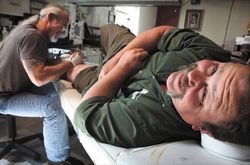 This is a wonderful article on Memorial Tattooing, or a tattoo that an individual chooses after a person or pet dies. The article also explains an old tattooing practice, namely the putting of cremated remains in the ink used for the tattoo. After my parents die I plan on having their cremated remains mixed into ink for new memorial tattoos.
This is a wonderful article on Memorial Tattooing, or a tattoo that an individual chooses after a person or pet dies. The article also explains an old tattooing practice, namely the putting of cremated remains in the ink used for the tattoo. After my parents die I plan on having their cremated remains mixed into ink for new memorial tattoos.
